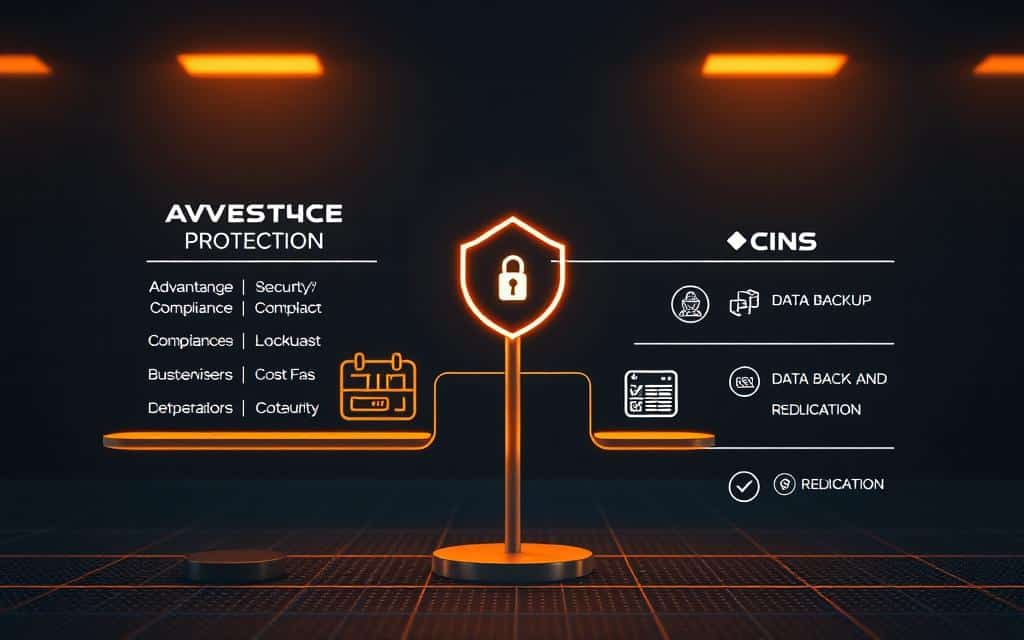Your business depends on data every minute of the day. Losing critical files could mean disaster—downtime, lost revenue, and damaged trust. Shockingly, 94% of small businesses faced cyberattacks in 2024, with ransomware damages expected to hit $265 billion by 2031.
That’s where smart data protection comes in. Whether you’re safeguarding customer records or financial details, choosing the right approach can mean the difference between quick recovery and catastrophic loss. This guide breaks down the essentials to keep your operations running smoothly.
We’ll explore how modern solutions like Unitrends’ HOT/COLD replication and the 3-2-1 backup rule help prevent data loss. With breaches costing businesses an average of $4.88 million last year, now’s the time to act.
What Are Backup and Replication?
Data is the lifeblood of modern operations, needing constant protection. Two core methods—backup and replication—serve as shields against loss. While both safeguard information, they work in distinct ways.
Defining Data Backup
Backup acts like a time capsule for your files. It captures snapshots of your data at specific intervals, storing them separately. Think of it as an insurance policy against ransomware or accidental deletions.
For example, healthcare systems rely on backups to restore electronic health records (EHRs) after cyberattacks. Architectural firms use incremental versions to retrace design changes.
Defining Data Replication
Replication creates real-time mirrors across locations. It’s like having a spare tire ready instantly—if one system fails, another takes over seamlessly. Financial institutions use this for uninterrupted transaction processing.
Unlike backups, replicated copies update continuously. This ensures zero downtime for critical operations, such as hospital patient databases.
| Feature | Backup | Replication |
|---|---|---|
| Frequency | Scheduled (hourly/daily) | Continuous |
| Use Case | Recovery from disasters | Instant failover |
| Storage Needs | High (multiple versions) | Moderate (current state only) |
Need help choosing? Explore our guide on disaster recovery planning for tailored advice.
How Backup and Replication Work
When disaster strikes, how quickly can you retrieve your critical files? The answer depends on which types of protection you use. Backup creates restore points, while replication keeps copy data synced in real time. Here’s how each method operates behind the scenes.

Backup Methods: Full, Incremental, and Differential
Imagine a hospital updating patient records. A full backup saves every file nightly—like photographing all charts at closing. It’s thorough but demands storage space. An e-commerce site might need 5TB for this approach.
Incremental backups only save changes. If a designer alters a project file, just the new edits get stored. This speeds up the process but requires all previous backups to restore data completely.
Differential backups strike a balance. They capture everything changed since the last full backup. For hospitals, this means faster recovery time than incrementals but less storage than daily full copies.
| Method | Speed | Storage Needed | Best For |
|---|---|---|---|
| Full | Slowest | Highest | Complete system restores |
| Incremental | Fastest | Lowest | Frequent small changes |
| Differential | Moderate | Medium | Balancing speed/space |
Replication Types: Synchronous vs Asynchronous
Banks use synchronous replication—every transaction updates across servers instantly. Your $100 transfer reflects everywhere before the next action begins. This ensures zero data loss but needs high-speed networks.
Asynchronous replication works like a multinational’s email system. Updates queue and sync periodically. Healthcare apps might use this for non-critical data, accepting slight delays to reduce bandwidth strain.
Latency matters. A 2-second lag in patient monitoring could be life-threatening, while delayed marketing analytics pose less risk. Choose based on your recovery point needs.
Backup vs Replication: Key Differences
Downtime costs businesses $5,600 per minute—how resilient is your setup? The right choice depends on two metrics: how fast you need systems running (RTO) and how much data you can afford to lose (RPO). Let’s break down the gaps.
Recovery Objectives (RTO vs RPO)
A retail POS system might tolerate 1 hour of downtime (RTO) but zero sales data loss (RPO). Hospitals, however, need sub-minute failover for patient monitors—delays risk lives.
During a ransomware attack, backups restore files to a point in time before infection. Replication keeps systems live but could mirror corrupted data. Law firms often combine both: backups for document versions, replication for email continuity.
Storage and Accessibility
Tape backups cost $0.03/GB but take days to retrieve. Cloud replication averages $0.12/GB with instant availability. Media companies use cold storage for old footage but replicate active projects globally.
| Factor | Backup | Replication |
|---|---|---|
| Cost (per TB/year) | $30 (tape) – $120 (cloud) | $240+ (geo-redundant) |
| Retrieval Speed | Hours to days | Instant |
| Best For | Long-term archives | Critical data protection |
Global businesses weigh these tradeoffs daily. A bank’s trading desk needs replication’s zero RPO, while HR departments might prioritize backup’s cost savings for payroll records.
Pros and Cons of Each Strategy
A construction firm’s blueprint archive and a stock trader’s ledger demand different solutions. One needs versioned restores; the other requires zero-delay failover. Here’s how to weigh your options.

Why Backup Shines for Long-Term Needs
The 3-2-1 rule (3 copies, 2 media types, 1 offsite) makes backups ideal for archives. Media companies use this for old footage—low cost, high safety.
For a business handling sensitive data, backups help meet compliance standards like HIPAA or GDPR. Healthcare systems retain patient records for years this way.
Replication’s Edge in Critical Operations
Stock trading desks rely on real-time copies to prevent downtime. A 2-second delay could cost millions. Synchronous replication ensures trades update globally instantly.
But speed has tradeoffs. Upgrading infrastructure for sync adds 40%+ to costs. SaaS firms often use multi-cloud setups to balance expense and continuity.
Limitations You Can’t Ignore
Backups take hours to restore—bad for applications needing 24/7 access. Replication mirrors corruption; ransomware attacks spread faster.
Hybrid approaches fix this. MSPs combine weekly backups (for rollbacks) with Ootbi’s immutable storage (tamper-proof copies). Best of both worlds.
Costs and Implementation
Smart budgeting separates thriving businesses from those struggling with unexpected IT costs. Whether you’re a school district or a tech startup, balancing protection and expenses matters. Here’s how to allocate funds wisely.
Budgeting for Backup Solutions
Tape storage costs $0.03/GB but needs physical space and slow retrieval. Cloud options like AWS S3 start at $0.023/GB for instant access. A 500TB archive saves $13,500/year with tapes—but is the delay worth it?
Some organizations mix both. A Nevada school district uses tapes for old records and cloud for active files. Their hybrid strategy cut costs by 40%.
Investing in Replication Infrastructure
Real-time systems need robust networks. Synchronous replication demands 10Gbps+ connections, adding $15,000/year in bandwidth. But for a Texas energy company, this prevented $2M/hour in downtime losses.
DRaaS solutions like Unitrends’ pay-as-you-grow model reduce upfront costs. One manufacturer saw 35% savings versus in-house setups.
| Solution | Upfront Cost | Annual Expense | Best Fit |
|---|---|---|---|
| Tape Backup | $5,000 (drive) | $1,500/TB | Non-urgent archives |
| Cloud Backup | $0 | $230/TB | Frequent access needs |
| Multi-Site Replication | $50,000+ | $12,000/TB | Zero-downtime operations |
Insurance providers often discount premiums by 20% for businesses with verified recovery plans. That’s free money for being prepared.
Choosing the Right Strategy for Your Needs
86% of breaches target businesses using just one protection method. A hybrid solution—like immutable backups paired with real-time sync—covers all bases. Healthcare needs instant access to patient records, while FinTech prioritizes zero-delay failover.
Start with a risk assessment. Rate your data by sensitivity and downtime costs. Critical systems? Prioritize replication. Archives? Backups work. The point: match the strategy to your workflow.
Zero Trust tools like Ootbi block 97% of ransomware. Pair them with Unitrends’ HOT/COLD replication for airtight security. Ready to build your plan? Get a demo tailored to your industry.